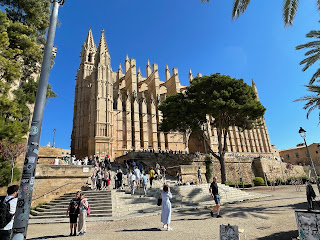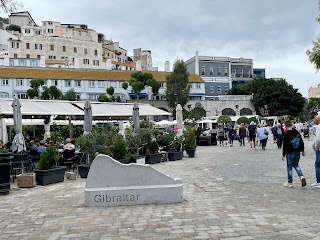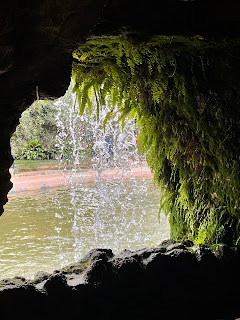This morning we arrived in Lisbon, one of my favorite cities. It was just after sunrise and if I do say so myself a couple of the photos I took from the stern of the ship came out pretty well. I didn't touch them up at all.


Lisbon is the capital of Portugal and lies near the mouth of the Tagus River. It is the second oldest capital city in Europe, after Athens. Archaeological digs have found evidence that there was an important Phoenician trading post here dating back to 1200 BC Over the millennia it was occupied by Celts, Romans, Germanic tribes after the fall of Rome, and Moors among others. In some of the architecture you can see Moorish influences, especially in the marvelous tile work on many buildings. The oldest part of the city is the Alfama district and that name is from Moorish words meaning “of the spring ” literally because that was where some of the earliest fresh water springs were found. The Alfama was one of the few parts of the city which survived a catastrophic earthquake and subsequent tsunami in 1755. Lisbon is built on hills and you need to have strong legs to walk around. Commanding the high point overlooking the city is the Castle of St. George.
It was from this city that many famous explorers set sail. Vasco da Gama, a Portuguese, was the first European to reach India by sea. He made the voyage around the Cape of Good Hope between 1497 and 1499. While he died in India, his remains are entombed in Lisbon at the Geronimos Monastery. We think of the Spanish explorers but we don’t always remember that at one time the Portuguese were as intrepid and in fact, the Pope had divided the world between Spain and Portugal.
Enough about that. I had arranged for a car and driver/guide to take me to some places I wanted to revisit. My wonderful driver Luis met me and we set out to our first stop the town of Sintra. Al and I went there several times to visit the palace there but that wasn’t my mission today. Sintra is a charming little town and the first time we went there (15 years ago) we had lunch and then we went to a little jewelry shop where he bought me a beautiful gold filigree pendant. Everyone always guesses it came from somewhere in the middle East, but that kind of work is unique to Portugal. Over the years we went back several times and he gave me other pieces. Today I wore the original pendant and treated myself to a new one. It wasn’t something I needed but it felt like the right thing to do.
The town hall of Sintra
When we left the shop it began to rain and that continued for the next few hours. Despite that we drove to the Cabo da Roca, the westernmost point on the European continent. There’s a monument and a lighthouse there and when the skies are clear a breathtaking view from the cliffs with waves crashing below. As the song goes “on a clear day you can see forever” except in this case you would see Maine. The area around the promontory has hardy little flowers growing which don’t seem to mind the wind and salt that’s always there and they have been dedicated as part of an international organization that works toward peace among nations (the world could use some of that now). Hence the flowers are called Sri Chimoya Peace Blossoms.


We left the cape and began the drive back toward Lisbon, winding our way through what I would call the Portuguese Riviera. Two cities along the way, Estoril and Cascais, have been for many years favorites of exiled kings, dictators, and entertainment celebrities. There’s an interesting story, at least to me, about these places. Portugal was nominally neutral during WWII. While it was neutral it was very popular with spies of all sides. (As a side note, if you have seen the movie Casablanca, all the people there were trying to get transit visas to Lisbon and Portugal to make their way to the US.) Anyway, in Estoril there was, still is, a casino. Supposedly there was a very dashing Hungarian spy who gambled there. Another gambler was a British man named Ian Fleming and many people think he modeled James Bond 007 after this sophisticated Hungarian. It sounds like a good story.
After wending our way along the coast we arrived back in the Belem district of Lisbon. That was the third place I wanted to stop. Belem is the home of the Monastery I mentioned earlier, a lovely monument to Portuguese Discoverers and the Belem Tower, an old watchtower on the Tagus. They weren’t my reason for going there though, and I’ll leave it to you to google photos of them if you’re interested or look back at older trips I wrote about on this blog to see them. I went there to get some Pasteis de Belem, the very famous custard tarts made here. This little café produces as many as 15,000 a day and one can sit and have a coffee and eat one or get them to go. There was a very long line, but Luis knew someone so we went in a special way and I bought some to go. I got enough for my trivia teammates and my cabin stewardesses because I felt that everyone who stops in Lisbon should try the pasteis at least once. (They were a big hit at our late afternoon trivia game.) Luis and I then had a light lunch at a little typical Portuguese place down the street.
On our way to Belem Luis took a little side trip to show me a most remarkable graffiti street art someone did. Can you tell what it is? Whoever painted it has real talent.
Then having driven down memory lane and thinking about wonderful times I had at these places, I told Luis I was ready to go back to the ship. All aboard was pretty early today so it was just the right amount of time that we spent. I sat in the front seat with Luis and we had an interesting conversation about all sorts of things from religion to politics and lots of things in between. I know, those are two things you shouldn’t talk about, but I found it was interesting to get the perspective of someone from a different country. It was a wonderful day and I’ve made a new friend.
Oh, the graffiti is a raccoon face. Do you see it? Tonight we go forward another hour and tomorrow we’ll be in Cadiz, Spain. So hasta mañana and buenas noches.
Oh, Katie, õ is pronounced with a very nasal “o” sound which Luis did several times but I couldn’t seem to get right.






























































